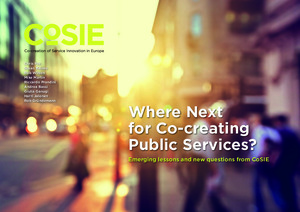Where next for co-creating public services? : emerging lessons and new questions from CoSIE
Fox, Chris; Baines, Susan; Wilson, Rob; Martin, Mike; Prandini, Riccardo; Bassi, Andrea; Ganugi, Giulia; Jalonen, Harri; Gründemann, Rob (2020)
Fox, Chris
Baines, Susan
Wilson, Rob
Martin, Mike
Prandini, Riccardo
Bassi, Andrea
Ganugi, Giulia
Jalonen, Harri
Gründemann, Rob
Turun ammattikorkeakoulu
2020
All rights reserved. This publication is copyrighted. You may download, display and print it for Your own personal use. Commercial use is prohibited.
Julkaisun pysyvä osoite on
https://urn.fi/URN:ISBN:978-952-216-772-9
https://urn.fi/URN:ISBN:978-952-216-772-9
Tiivistelmä
This publication draws together some of the ‘big ideas’ emerging from the Horizon2020 project CoSIE (Co-creation of Service innovation in Europe) in the form of a discussion paper aimed at European, national and regional policy-makers. The big ideas emerging from CoSIE can be grouped together as ideas associated with 1) conceptualising co-creation, 2) implementing co-creation and 3) evidencing and evaluating co-creation in public service reform.
CoSIE assumes that co-creation becomes innovative if it not only concerns the reduction of the public expenditure, but if it manages also to meet social needs, and to empower the beneficiaries of policies, by changing socio-political relations and redistributing socio-political responsibilities.
More specifically, it aims to a) advance the active shaping of service priorities by end users and their informal support network and b) engage citizens, especially groups often called ’hard to reach’, in the collaborative design of public services. One way it does this is through the development of ten pilot cases, embedded in national contexts, which strongly differ in socio-cultural, socio-political and socio-economical dimensions.
CoSIE assumes that co-creation becomes innovative if it not only concerns the reduction of the public expenditure, but if it manages also to meet social needs, and to empower the beneficiaries of policies, by changing socio-political relations and redistributing socio-political responsibilities.
More specifically, it aims to a) advance the active shaping of service priorities by end users and their informal support network and b) engage citizens, especially groups often called ’hard to reach’, in the collaborative design of public services. One way it does this is through the development of ten pilot cases, embedded in national contexts, which strongly differ in socio-cultural, socio-political and socio-economical dimensions.
